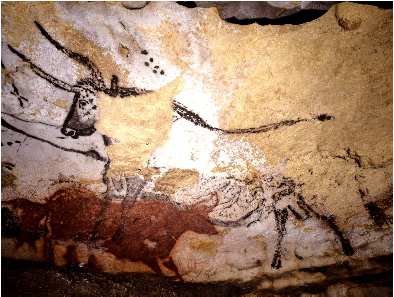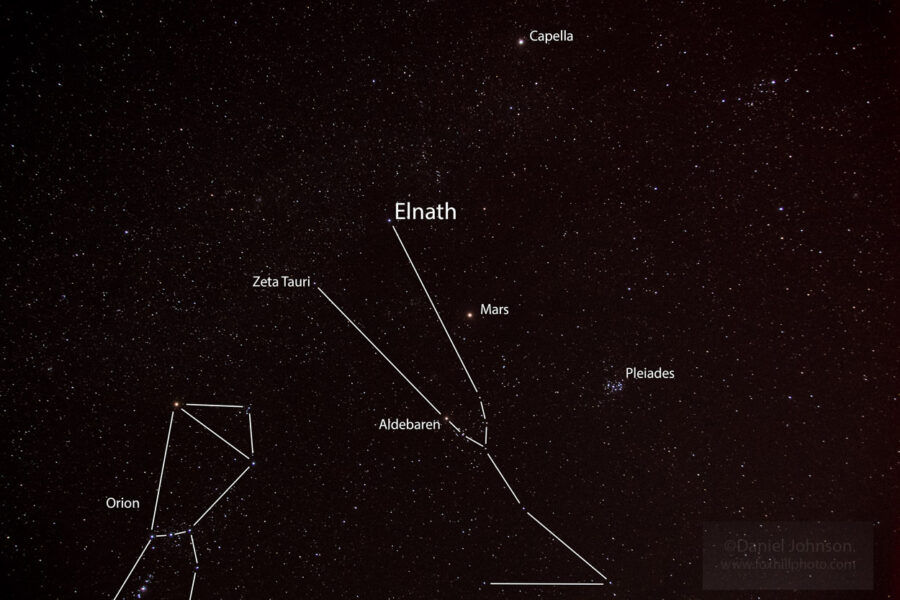Elnath, the bright, blue-white star that marks one of the horns of Taurus, is a peculiar star in its own right.
The Vitals
| Official name | Elnath |
| Other designations | El Nath, Alnath, Beta Tauri, HR 1791, HIP 25428, HD 35497 |
| Nicknames | - |
| Apparent magnitude | 1.65 |
| Distance from Earth | 134 light-years |
| Type | B7 III |
| Color | Blue |
| Mass | 4.2 M☉ |
| Radius | 4.6 R☉ |
| Constellation | Taurus |
| Right ascension | 05h 26m 17s |
| Declination | +28° 36' 26" |
| Multiple system? | No |
| Variable star? | No |
| Exoplanets status | None known |
| Probable fate | Planetary nebula |
Physical Characteristics
Taurus offers plenty to keep astronomers busy. Besides bright Aldebaran and the Pleiades, there’s the famous Crab Nebula, the Hyades star cluster, and the annual Taurids meteor shower. Given these wonders, we wouldn’t blame you if you haven’t stopped to explore Elnath, the constellation’s second brightest star. But you should. It’s a unique star with some interesting attributes.
Elnath is technically classified as a giant star, but this isn’t a monster in the league of Betelgeuse or Rigel. It’s only 4 to 5 times larger than the Sun. Nevertheless, Elnath pours out a phenomenal amount of energy, shining with a brightness 500 times the Sun’s luminosity. From Earth’s distance, it’s the 25th brightest star in the night sky. Elnath is hot and has a correspondingly blue color.
Perhaps the most interesting aspect of Elnath is its peculiar chemical composition. Elnath, like the Sun, is mostly hydrogen and helium, but it has 25 times more magnesium than the Sun does. At the same time, compared to solar values, it has eight times less calcium and manganese. There’s a kind of chemical diffusion happening in these stars, causing atoms of some elements to rise and others to fall deeper within the star.
Because of this, mercury-manganese stars like Elnath sometimes exhibit chemical spots, where the chemical composition differs from the rest of the surface. This phenomenon is different from the dark sunspots we see on the Sun, generated by solar magnetic fields.
Origin / Mythology
While many of the current constellations have a Greek origin, many individual star names come from the Arabic tradition. Elnath is one of these. The name, which in Arabic means “butting” or “goring” and is a direct reference to the Bull’s horns, provides the viewer with context for imagining Taurus. (The constellation typically represents only the front half of the Bull).

Emilia Pasztor / Research Gate
Many Northern Hemisphere constellations are ancient, but Taurus is particularly so, with some associated Mesopotamian myths dating back 4,000 years or more. One ancient painting of a bull in the Lascaux caves in France might actually be a rendition of Taurus, with six dots above its back representing the Pleiades. If this interpretation of the ancient painting is correct, than humans may have been connecting Elnath with Taurus’ horns for even longer than the written Mesopotamian records.
How to See Elnath

Daniel Johnson
Taurus is conveniently located for evening viewing in the fall and winter, northwest of Orion and crowned by the vividly red Aldebaran. If Aldebaran is imagined to be the Bull’s eye, Elnath is the tip of its left horn (on our right), forming a deep “V” shape with Aldebaran and the fainter Tianguan (Zeta Tauri).
Elnath is near the galactic plane, almost exactly opposite the sky from Sagittarius, in a sparse location known as the galactic anticenter. By the time spring arrives, Taurus fades away into the glare of the Sun, reappearing on the other side the following autumn.
Stargazers who know their constellations will notice that Elnath is pretty close to Auriga (that charioteer holding those goats). Constellation boundaries are dynamic, changing over the course of history. The ancient astronomer Ptolemy included Elnath as part of Auriga, and in those days Elnath was sometimes referred to as Gamma Aurigae.
Taurus is a zodiac constellation, and thus visited frequently by the Moon, planets, and during the summer, the Sun. Stay on the lookout for these visitors.
When gazing up at the night sky it’s fun to remember that many of those points of light are stars that are similar to our own Sun. But Elnath provides the opportunity to imagine a different type of Sun — one bluer, with a quieter atmosphere, and made of somewhat different materials. What might it look like close up? Even if you can’t go there to see, there’s nothing stopping you from exploring Elnath from a distance tonight. What are you waiting for? Step outside, and take the Bull by the horns.
Daniel Johnson is a Wisconsin-based freelance writer and professional photographer and the co-author of over a dozen books. He’s a longtime amateur astronomer and fortunate enough to live in a rural region with excellent seeing conditions. You can view some of Dan’s photography (he does a lot of animals!) at foxhillphoto.com
 5
5









Comments
misha17
April 5, 2023 at 3:25 pm
Since the Moon's orbit is tilted 5 degrees from the Ecliptic, it can occult stars up to 5 degrees above or below the Ecliptic as its orbit does an 18-year movement against the stellar backdrop.
Elnath lies ~just~ at the northern limit of the Moon's path in the sky, and we are approaching its "occultation season" as the lunar "high point" retrogrades towards Taurus. Because Elnath lies so far north of the Ecliptic, occultations are only viewable from southwards about the Tropic of Cancer. The occultation series runs from September 2023 thru May 2027, starting and ending with occultations only viewable from Antarctica.
( Source: https://earthsky.org/tonight/moon-in-taurus-on-january-evenings/ )
In the U.S., San Diego (CA) lies at about the northern limit to see an occultation.
You must be logged in to post a comment.
misha17
April 5, 2023 at 3:32 pm
Even though most US viewers will not see an occultation, they will enjoy 4 years of very close conjunctions, and can watch the Moon slowly creep closer and closer to the star through late Spring 2025 (in the evening sky) and late Summer 2025 (in the morning sky), then begin moving more south of the star after that.
You must be logged in to post a comment.
ribwoods
April 5, 2023 at 4:04 pm
Third paragraph: "calcium and manganese" s/b "calcium and magnesium"
You must be logged in to post a comment.
Erik Moore
April 5, 2023 at 6:07 pm
I like these “meet” posts. Typo between manganese and magnesium. /smile. Should be “more manganese than the Sun does. At the same time, compared to solar values, it has eight times less calcium and magnesium”
You must be logged in to post a comment.
Yaron Sheffer
April 7, 2023 at 10:12 am
While the manganese vs magnesium battle is still raging on, I try to imagine those Lascaux night skies of 20,000 years ago. Zero cities. Zero cars. Zero airplanes. Zero satellites. Zero light pollution, except for that pesky fire still burning inside Zorg le Artiste's cave after moonset. Nights that must've registered negative on the Bortle scale, with each and every star piercing the velvety black sky with diamond-like brilliance. ("Yo, Zorggy! Enough with painting on your ceiling each and every night!")
You must be logged in to post a comment.
You must be logged in to post a comment.